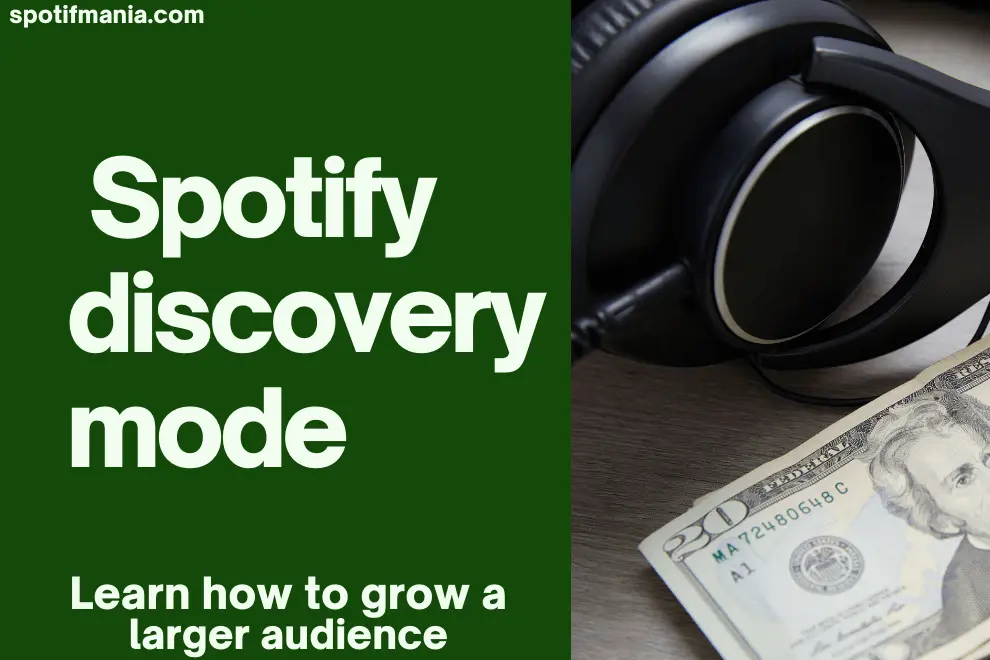Spotify Discovery Mode(What Is It And How To Use It?)

Are you an artist posting your tracks on Spotify? Then, you must be aware of how tough it is to get Spotify users to listen to your songs. Because your songs never reach them. To solve this problem for the artists, Spotify has launched a new feature called Spotify discovery mode.
Many people don’t know about Spotify Discovery mode, how to access it, or its advantages. For such people, I’m writing this article in which I’ll be telling you about the Spotify discovery mode and how it can help you as an artist on Spotify.
Keep reading.
What is Spotify Discovery Mode?
Discovery Mode is a new feature launched by Spotify to help all the struggling artists get success with their tracks. This tool helps the artists grow their fanbase by helping them reach a wider audience most likely to be interested in their music.
You can consider Spotify discovery mode like a Facebook or Google ad campaign. In this mode, whichever track you release, you can advertise that on Spotify not through ads but through the radio, personalised listening sessions, and autoplay.
When you launch a discovery mode campaign for any of your tracks, Spotify makes it available to those interested in listening to the type of music you’ve made.
This way, your audience grows, and you make a very strong fanbase. But remember, there is no guarantee that you’ll get millions of followers or listeners with the Discovery mode. What kind of listeners your song attracts will determine the response you get at the end of the day.
How Does Spotify Discovery Mode’s Algorithms Work?
When you set any of your tracks to discovery mode, you’re telling Spotify that this is the song you want more and more people to listen to. The Spotify algorithm then takes your song and puts it into the recommendations on autoplay, personalised listening sessions and radio.
But your track is recommended to only those users who like listening to the type of music you make. The Spotify algorithm has the listening history of all the listeners on its platform, and thus, it knows what type of music they’re interested in.
This is why the discovery mode is the best option to get your track listened to by only interested individuals. What’s the process for using Spotify Discovery Mode?
How Much Does Spotify Discovery Mode Cost You?
For those people who think that Spotify discovery mode is free, then you’re very wrong, man. Spotify takes a 30% commission on all streams of tracks included in a Discovery Mode campaign.
Spotify Radio and Autoplay streams are the only ones that get this commission. You can’t pay for streams from playlists and searches. Let’s say you launch a Discovery Mode campaign for a new song. The budget is $500 daily, running for 30 days. If you get 100,000 streams, Spotify’s going to take $30,000.

I hope you got to the point. Let’s get to the most important part: how do you use Spotify discovery mode?
How Do You Use Spotify Discovery Mode?
Using the Discovery Mode feature isn’t such a difficult thing to do. However, as I’ve mentioned above, this feature is only for artists and music labels. It’s not for everyone. Thus, there is a specific criteria that you must meet in order to use Spotify Discovery mode.
Eligibility Criteria of Spotify Discovery Mode:
The Spotify Discovery mode is available once you meet those criteria, but how do you know if you’re eligible?
How Would You Know If You’re Eligible For Spotify Discovery Mode?
You can check your eligibility for Discovery Mode by going to your Spotify for Artists dashboard and clicking the Campaigns tab. In case you’re eligible, you’ll see a Discovery Mode button. If you’re not eligible for the feature, you won’t be able to see it on the dashboard of your Spotify.
Now, the question is, how do you launch a campaign on Discovery mode? I’ll teach you how to do that.
Launching a Spotify Discovery Mode Campaign:
The first step to launching a Spotify discovery mode is to meet the criteria I’ve told you about. If you see it, follow these steps.
- Access Your Spotify for Artists Dashboard: Log into your Spotify for Artists account or make one if you don’t have one yet.
- Navigate to the Campaigns Tab: Once you’re in your dashboard, find the “Campaigns” tab. This is where you manage all your Spotify marketing efforts, including Discovery Mode campaigns.
- Open Discovery Mode: Within the “Campaigns” tab, you’ll see a section called “Discovery Mode.” Click on it to access the Discovery Mode campaign setup page.
- Start Setting Up Your Campaign:
- You can start a campaign by clicking the “Set up campaign” button. This starts the creation of a new Discovery Mode campaign for your music.
- Choose Your Priority Tracks: Select the songs you want to give extra attention to. You can pick up to 5 tracks for your campaign. These are the songs that will be promoted through Discovery Mode.
- Next Step: Go to the next page by clicking “Next.”.
- Set Your Budget and Duration: Here, you’ll decide how much money you want to spend on your campaign and how long you want it to run. You can choose a budget ranging from $50 to $5,000 per day, and your campaign duration can be anywhere from 1 to 30 days.
- Submit Your Campaign: After you’ve decided on your budget and duration, click the “Submit” button. This sends your Discovery Mode campaign for review, and if everything looks good, it will go live to help your music reach more listeners on Spotify.
That’s how you can use Spotify discovery mode to launch a campaign for your track on Spotify. Are there any benefits or drawbacks to Spotify’s discovery mode?
Benefits And Drawbacks:
Yes, there are some Spotify Discovery Mode benefits as well as drawbacks. Let’s talk about each and start with the benefits first.
Benefits of Spotify Discovery Mode:
Drawbacks Of Spotify Discovery Mode:
These are the benefits and drawbacks of using Spotify discovery mode that you must keep in mind. What if you don’t meet the eligibility criteria?
Alternatives To Spotify Discovery Mode:
The eligibility criteria for Spotify discovery mode are a little tough for artists new to Spotify. What if you don’t meet the criteria? If you don’t meet the criteria, then it’s okay. There are other amazing features on Spotify as well that will help you get your song heard by a wide audience. I’m going to walk you through each alternative one by one. Let’s dive into the topic now.
Spotify’s radio stations offer a personalised music experience just like Discovery Mode. They play songs based on your preferred genre, mood, or favourite artists. Radio stations are great when you’re unsure what to listen to, as they introduce you to new tracks and artists within a specific style. While Discovery Mode tailors recommendations, radio stations provide diverse music to match your mood or interests.
Spotify’s extensive playlist collection, curated by experts and users, spans every genre and mood. Playlists serve as pre-arranged music sets, akin to Discovery Mode’s recommendations.
With them, you can dive into specific themes or vibes while getting a guided music exploration. Playlists aren’t the same as Discovery Mode’s personalised suggestions, so they’re great if you want to explore a particular genre or mood.
Spotify’s “Genres and Moods” feature allows you to explore music based on your current feelings or interests. It’s a manual but effective way to discovery new artists and songs that align with your vibe.
You can browse by genre or mood instead of Discovery Mode, which suggests music based on your interests. It’s a hands-on alternative to music discovery, offering a personalised experience based on your preferences.
Keeping up to date on the latest music from your favourite artists and discovering new talent is easy with Spotify’s New Releases. This feature complements Discovery Mode, so you don’t miss out on new tracks. Keeping up with your favourite artists and exploring new releases is especially useful with this feature.
New Releases is an indispensable resource for staying on top of the latest music news, whereas Discovery Mode offers personalised recommendations.
Friends Music discovery is socially enhanced on Spotify thanks to the ability to see what your friends are listening to and share music.
It connects with Discovery Mode by giving you recommendations based on your friends’ preferences and trending tracks in your social circle. While Discovery Mode relies on algorithms, friends add a unique social dimension to discovering new songs. This approach offers personal insights and a sense of musical camaraderie.
It’s common for music labels and artists to promote their latest music on social media platforms. By following your favourite artists on Instagram, Twitter, and Facebook, you’ll know about new releases and discovery new tracks from them.
Spotify’s algorithms don’t limit music discovery to social media. Direct access to artists and their music makes it easier to discovery new music and stay connected with what you like.
You can find music you like using third-party apps. Some recommend music based on your listening habits, while others let you search by mood, genre, or lyrics. You can find music that aligns with your preferences and interests using these apps, which complement Discovery Mode’s features. In addition to Spotify’s Discovery Mode, third-party apps can broaden your musical horizons and cater to different tastes.
FAQs:
How do I turn on discovery mode on Spotify?
To turn on Discovery Mode on Spotify, you must be eligible. To be eligible, you must have at least 3 tracks that meet the track eligibility criteria and at least 25,000 monthly listeners.
Is Spotify discovery mode available for everyone?
Spotify Discovery Mode is not available for everyone. It is only available to artists and labels that meet the eligibility criteria.
Is Discovery mode free on Spotify?
Spotify Discovery Mode is not free. Spotify takes a 30% commission on all streams of tracks that are included in a Discovery Mode campaign.
Conclusion
Spotify Discovery Mode is a special new tool launched by Spotify to help all of the artists create a large fan base. It’s only available to those who meet the eligibility criteria for the Spotify discovery mode that I’ve mentioned above.
